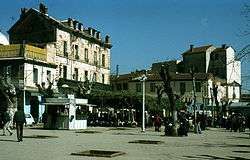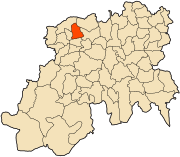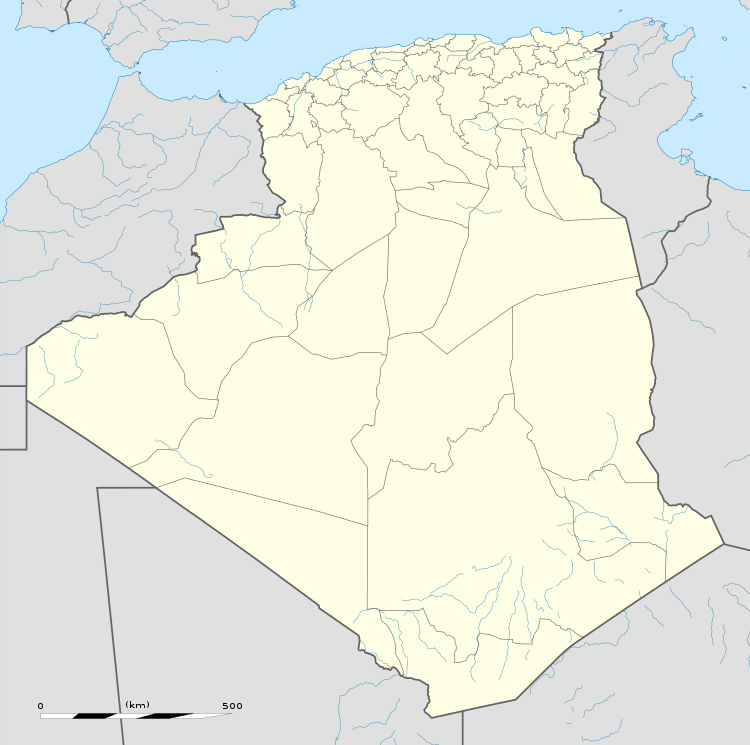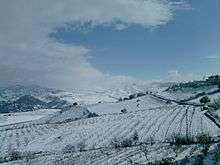Médéa
Médéa (Berber languages: Lemdiyyet, Arabic: المدية al-Madiya), population 123,535 (1998 census) is the capital city of Médéa Province, Algeria. It is located roughly 68 km south of Algiers.
Médéa al-Madiya المدية | |
|---|---|
 | |
 | |
 Médéa | |
| Coordinates: 36°16′3″N 2°45′0″E | |
| Country | |
| Province | Médéa Province |
| District | Médéa District |
| Area | |
| • Total | 63.5 km2 (24.5 sq mi) |
| Elevation | 1,036 m (3,399 ft) |
| Population (2008 census) | |
| • Total | 145,441 |
| • Density | 2,300/km2 (5,900/sq mi) |
| Postal code | 26000 |
The present-day city is situated on the site of an ancient Roman military post and has a history dating back to the 10th century. The town is French in character, with a rectangular city plan, red tile-roofed buildings, and beautiful public gardens. The hills surrounding Médéa are covered with vineyards, orchards, and farms that yield abundant grain. Médéa's chief products are wines, irrigation equipment, and various handicrafts.
Etymology
Medea is a Roman city named ad Medix or Media ("halfway" in Latin), so called because it was equidistant from Tirinadi (Berrouaghia) and Sufnsar (Amourah) rest house of Mauretania caesarean on the road linking the capital Caesarea (Cherchell) to the colony Auzia (Aumale). [2]
History
During the Roman Empire there was a settlement called Lamdia at Médéa. During the Roman Empire the town of Lamdia,[3] was the seat of an ancient Christian bishopric of the Roman province of Mauretania Caesariensis.[4] Only one bishop of the town is known. The Donatist Felix, attended the 411 Conference of Carthage. The town at that time had no Catholic bishops. Today Lamdia survives as a titular bishopric of the Roman Church and the current bishop is Marian Eleganti, bishop of Chur.
Following the defeat of the Berbers in the 11th century, Arab tribes of Hilal and Sulaym descent were settled in the region, mixing with and Arabicizing the local Berbers.[5]
Médéa was the capital of Titteri; a Bey, deputy of the Dey of Algiers, was resident there. The beylik of Titteri (chief Medea) was established in 1548. The last Bey Mostefa Boumezrag ran it from 1819 to 1830, when the French arrived. In 1837, after the Treaty of Tafna, Medea became one of the capitals of the part of Algeria ruled by Abdelkader El Djezairi, but was occupied by the French when they eventually took possession of the whole of Algeria. Until 1962 Médéa was a garrison town for the French army.[6]
Economy
One of the largest pharmaceutical production units in Algeria (Saidal-Antibiotical) is located in Medea.
Shoe factories also established in Takbou and M'salah.

Notable people
- Amine Megateli - Professional footballer
- Jean Richepin - French poet and writer, member of Académie française
- Djamel Tlemçani - Professional footballer
See also
References
- http://www.mundomanz.com/meteo_p/pr_data?ind=60437
- "geographie de l'afrique du nord,le titteri des francais,les localites,medea,djelfa,boghari,paul-cazelles,bouchet;alger-roi.fr". alger-roi.fr. Retrieved 2015-11-07.
- Lamdia at GCatholic.org.
- J. Mesnage, L'Afrique chrétienne, (Paris, 1912), p.460.
- "François Decret, Les invasions hilaliennes en Ifrîqiya - Clio - Voyage Culturel". www.clio.fr. Retrieved 2015-11-07.
- Ted Morgan, page 59 My Battle of Algiers. ISBN 0-06-085224-0.
.svg.png)